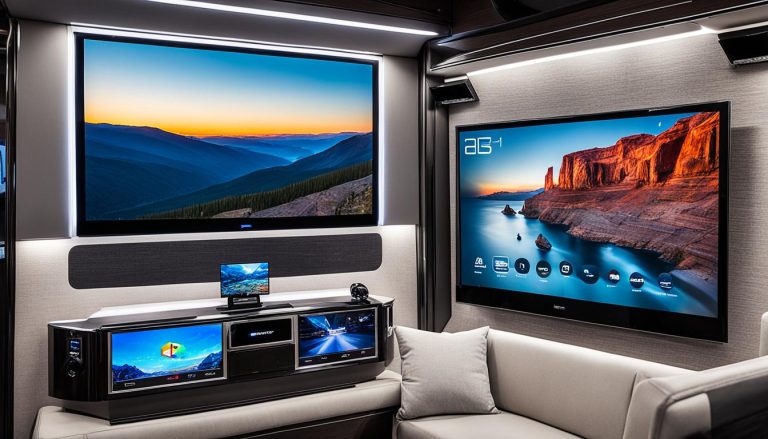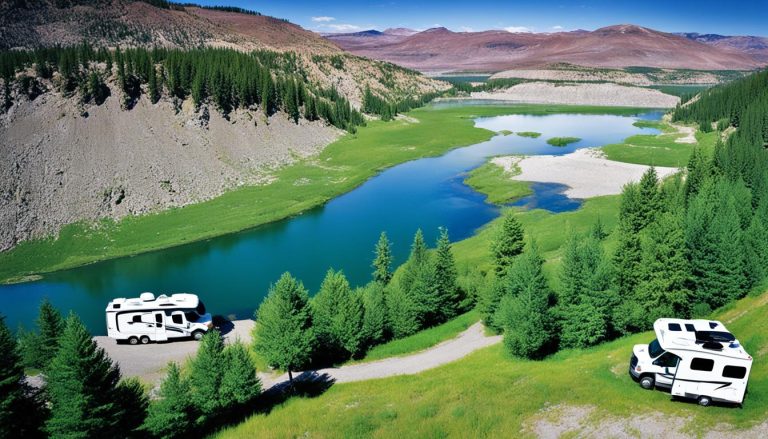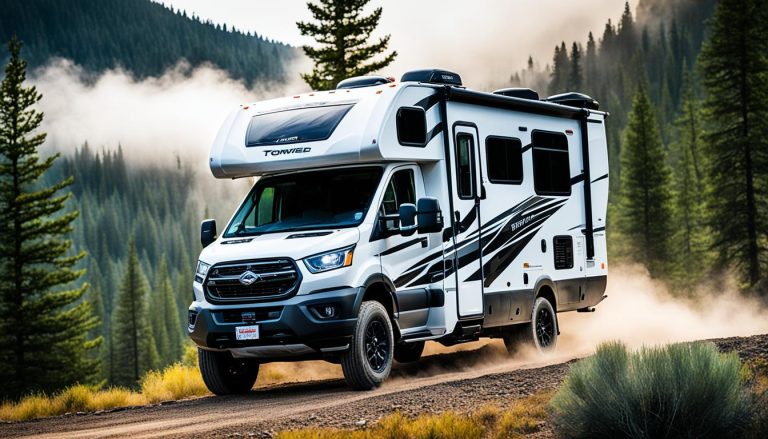Optimize Caravan Safety with Noseweights Guidance
gorvlifestyle.com and its partners may earn a commission if you purchase a product through one of our links
Ensuring caravan safety on the open road is an invaluable aspect of any RV adventure, and a key component of that safety is understanding and managing your caravan’s noseweights. Neglecting the consideration of adequate noseweights – the trailer hitch force that keeps your vehicle steady and anchored – can turn a serene trip into a stressful ordeal. Proper caravan weight distribution isn’t just about compliance; it’s a fundamental aspect of towing safety, affecting everything from steering control to tire integrity. As caravanners crisscross the highways, knowledge and application of this principle are as essential as the hitch locking onto the caravan itself.
Key Takeaways
- Noseweights play a vital role in maintaining stability while towing a caravan, preventing undesirable swaying and improving vehicle control.
- Understanding the recommended trailer hitch force ensures not only safety but optimization of vehicle performance and adherence to legal standards.
- Caravan weight distribution must be managed properly to sustain grip on the road and minimize wear on tires.
- Regular checks of the caravan’s noseweight before each journey are a must for continuous safety and peace of mind.
- Compliance with the manufacturer’s guidelines for both caravan and towing vehicle can forestall potential accidents and legal issues.
- Adjusting and balancing load within the caravan is key to achieving the ideal noseweight for a safer towing experience.
Understanding Caravan Noseweight and Its Critical Role in Towing
When it comes to caravan towing, mastering the essentials of caravan hitch force and trailer tongue weight is not only a practice of diligence but a commitment to safety. The term ‘noseweight’ may seem technical, but its implications on the road are practical and impactful.
Defining Caravan Noseweight
Caravan noseweight is the downward pressure that the hitch of a caravan applies to the tow ball of a vehicle. It is a critical factor in the towing dynamics that affects everything from steering to the wear and tear on your vehicle.
A noseweight that is well within the prescribed limits optimizes the RV coupling force, ensuring that the connection between your vehicle and caravan is secure and stable. This weight plays a crucial role and should be measured accurately before any journey.
Why Correct Noseweight is Essential for Caravan Stability
Having the correct noseweight is the linchpin for maintaining caravan stability. If this weight is too light, it can lead to dangerous swaying and a loss of steering control. Conversely, if it’s too heavy, it increases the likelihood of tire damage or blowouts and puts undue strain on the tow vehicle, potentially compromising its efficiency.
Setting the right noseweight is a balance that respects the complex physics of towing. It ensures that the trailer tongue weight is optimized for providing enough downward force to maintain traction while avoiding excessive pressure that could lead to mechanical failures or erratic towing behavior.
In essence, staying informed and vigilant about noseweight and the forces at play when towing can mean the difference between a safe journey and a perilous one.
Noseweights – force of your caravan’s coupling head
The concept of caravan coupling head is at the forefront of towing safety, representing the pivotal force measurement that keeps the trailer secure and in control while on the move. The coupling head connects the caravan to the towing vehicle, thereby transmitting forces that are elemental in towing dynamics. A suitable caravan coupling head will ensure an evenly distributed load, fostering a level ride and reducing the strain on the vehicle’s suspension and brakes.
Towing safety cannot be compromised, and the intricacies of force measurement are crucial in maintaining a harmonious drive. Proper adjustment of the caravan’s noseweight is vital—it must harmonize with the towing capacity recommended by the manufacturers. Failing to adhere to these regulations can not only affect the caravan’s stability but can lead to potential road hazards.
The table below provides a snapshot of what to consider when checking the force on your caravan’s coupling head:
| Consideration | Details |
|---|---|
| Caravan Towing Capacity | The maximum weight your caravan is designed to tow, as specified by the manufacturer. |
| Vehicle Towing Limits | The suggested pulling capacity of the towing vehicle, determined by the make and model. |
| Coupling Head Compatibility | Matching the coupling head’s rating to both the caravan and towing vehicle capacities. |
| Balance and Weight Distribution | Ensuring the weight is evenly distributed for stability during motion. |
| Legal Requirements | Adhering to the legal towing limits and regulations to avoid penalties. |
With the emergence of new models and technologies, the process of measuring and maintaining the correct noseweight has become more user-friendly. Recreational vehicle enthusiasts and experts concur on the importance of regular checks and adjustments to the caravan coupling head before hitting the road. Remember, paying attention to these details not only prolongs the life of your caravan and tow vehicle but also ensures a safer traveling experience for everyone on the road.
How to Determine the Ideal Noseweight for Your Caravan
Ensuring your caravan is correctly balanced is not just a concern for handling and stability, but also mandatory for legal compliance on the roads. This segment of our guide focuses on the important aspects of towing capacity, caravan weight distribution, and adherence to manufacturer’s guidelines for maintaining the ideal noseweight for your caravan. Let’s delve into the established procedures and calculations that facilitate a safe journey down the open road.
Assessing Caravan and Tow Vehicle Manufacturer Guidelines
The cornerstone of determining the right noseweight for your caravan begins with consultation of the manufacturer’s specifications. It’s essential to recognize and not exceed the limits set forth by both the caravan and tow vehicle. This data can often be found in the owner’s manual or by contacting the manufacturer directly. Violating these guidelines can lead to significant safety issues and potential legal consequences.
Calculating Noseweight Proportions: The 5-7% Rule
To calculate the appropriate caravan noseweight, you can use a simple rule of thumb: it should generally represent 5-7% of the caravan’s laden weight. This percentage helps to achieve a balanced weight distribution, ensuring that the towing setup is both safe and optimized for performance. Here’s a quick guide to help you understand the calculation:
| Caravan Laden Weight | Minimum Noseweight (5%) | Recommended Noseweight (7%) |
|---|---|---|
| 1000 kg (2205 lbs) | 50 kg (110 lbs) | 70 kg (154 lbs) |
| 1500 kg (3307 lbs) | 75 kg (165 lbs) | 105 kg (231 lbs) |
| 2000 kg (4409 lbs) | 100 kg (220 lbs) | 140 kg (308 lbs) |
Keep in mind, while this table serves as a guideline, it is the specifications from your caravan and vehicle manufacturers that will provide the decisive figures applicable to your specific setup. By dedicating attention to these details, caravanners will be better positioned for a seamless travel experience, ensuring the safety of their vehicle, their caravan, and their fellow road users.
Practical Steps to Measure Caravan Noseweight Accurately
Ensuring the safe and stable towing of a caravan starts with accurately measuring caravan noseweight. This crucial step dictates the distribution of weight and impacts your caravan’s overall towing dynamics. Below, we delve into the methodologies available to caravan owners: the precision of a certified noseweight gauge and the ingenuity behind a DIY noseweight measurement technique. Whether you’re a seasoned caravaner or a newcomer to the world of recreational vehicles, mastering these methods is fundamental for a secure travel experience.
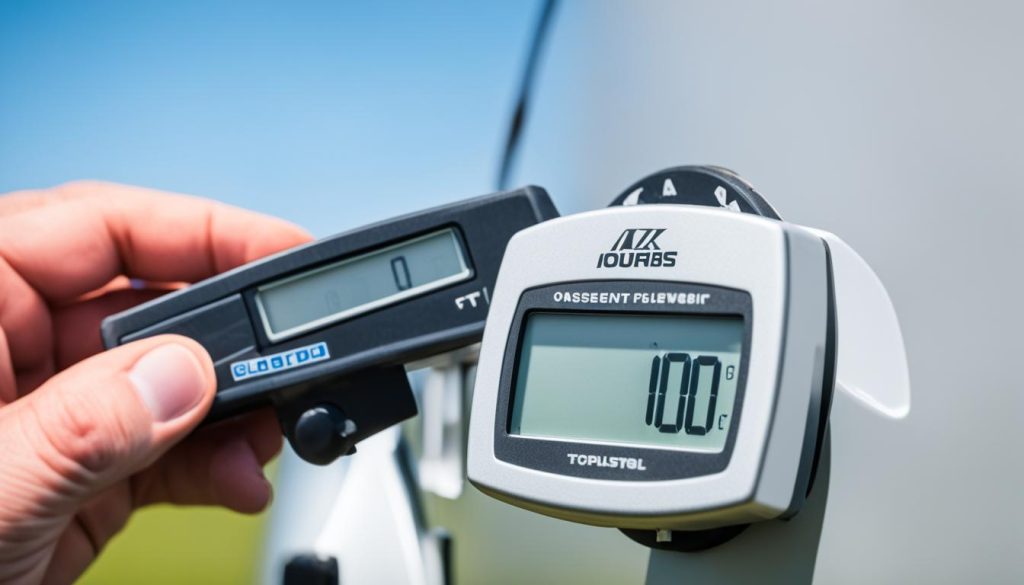
Utilizing a Noseweight Gauge for Precision
One of the most reliable methods to assess noseweight is through the use of a noseweight gauge. This specialized tool is designed to measure the downward force exerted by the caravan’s hitch onto the tow ball. For a valid reading, ensure the gauge adheres to standards such as the British Standard mark. The procedure is straightforward:
- Position the gauge directly under the caravan’s tow hitch.
- Lower the hitch onto the gauge until it bears the full noseweight of the caravan.
- Read off the value indicated on the noseweight gauge.
It’s recommended to perform this measurement with the caravan fully loaded as it would be for a typical journey, allowing you to adjust the load accordingly to meet the required noseweight specifications.
DIY Techniques: Measuring Noseweight with Bathroom Scales
For caravan enthusiasts keen on a do-it-yourself solution, common household items like bathroom scales can be repurposed for measuring noseweight. This method may require additional household items such as a sturdy wood plank and a broom handle, serving as a lever system to simulate the noseweight gauge functionality. Follow these steps to ensure an accurate measurement:
- Place the bathroom scales on firm ground and set up the plank and handle to distribute the weight evenly.
- Carefully lower the caravan’s hitch over the setup so the scales register the weight.
- Take note of the measurement shown and confirm that it aligns with recommended levels.
This approach provides a cost-effective alternative to the branded gauges while still offering a credible assessment of the caravan’s noseweight.
| Noseweight Measurement Method | Tools Required | Cost | Accuracy | Preparation Time |
|---|---|---|---|---|
| Gauge | Noseweight gauge | Higher | High | Minimal |
| DIY | Bathroom scales, wood plank, broom handle | Lower | Medium to High* | Some setup required |
* Accuracy for DIY methods can vary based on the precision of the scales and the user’s ability to set up the lever system correctly.
Regardless of the chosen method, the significance of maintaining an accurate caravan noseweight cannot be overstated. It’s integral to not only abide by legal requirements but also to ensure the safety of your vehicle, caravan, and passengers. Regularly measuring caravan noseweight contributes to a smoother driving experience, reducing the chances of instability and contributing to the overall enjoyment of your caravan adventures.
Adjusting and Balancing Noseweight for Optimal Safety
Towing a caravan or trailer demands meticulous attention to safety procedures, particularly when it comes to adjusting caravan noseweight and balancing trailer load. Ensuring the correct distribution of weight across the caravan not only contributes to towing safety but also enhances the overall driving experience, making it smoother and more controlled.
To establish the necessary balance and adhere to safety standards, it’s vital to locate heavier items closer to the floor and ideally, directly above the axle or slightly forward. This equidistribution mitigates the risk of tail sway or jack-knifing. In cases where the correct noseweight cannot be achieved within the caravan itself, transferring some of the load to the towing vehicle might be necessary.
Properly adjusting the noseweight is not just a recommendation, but a cornerstone of responsible caravan handling. The practice safeguards against erratic movements and ensures a stable journey.
- Position heavy objects low and central to reduce the risks of instability.
- Redistribute weight from the front to behind the axle if the noseweight exceeds the recommended limit.
- Use luggage to counterbalance the noseweight by carefully placing it within the caravan or in the tow vehicle.
- Regularly check the caravan’s noseweight using certified gauges, particularly after adding or removing items from the load.
In summary, the constant management of a caravan’s noseweight is indispensable for a safe towing venture. It’s a series of calculated adjustments that together, yield a harmonious balance—preventing undue strain on the towing vehicle, optimizing maneuverability, and refraining from disrupting the serenity of the journey.
Frequency of Noseweight Checks: Ensuring Continuous Safety
For those who frequently travel with caravans, noseweight checks are crucial for maintaining optimum towing dynamics and ensuring safety on the roads. These regular assessments are not just a one-time box to tick but an essential habit to develop for any responsible caravan owner. Prior to every departure and upon return, a thorough check is recommended to avoid the progression of potentially hazardous towing conditions.
Preparing for Departure: The Right Time to Check Noseweight
Embarking on a journey calls for a careful review of your caravan’s noseweight. To ensure a smooth start, experts recommend checking the noseweight when the caravan is fully loaded and ready for travel. This guarantees that your setup adheres closely to safety guidelines and prevents last-minute adjustments that could delay departure.
The Importance of Consistency in Noseweight Monitoring
Continuous safety throughout your travel experiences is maintained by consistent monitoring of your caravan’s noseweight. Regular observation and adjustment are fundamental in safeguarding against the unpredictable shifts in load that can occur while on the move. It is the diligent attention to detail that often differentiates a trouble-free trip from one marred by avoidable challenges.
Emphasize on the importance of these practices cannot be overstated. Tow vehicles and caravans are subject to varying conditions and even the smallest change in load can impact towing dynamics. Through routine noseweight checks, you are reassured that your caravan remains within safe operating parameters, providing peace of mind and enhancing your travel experience.
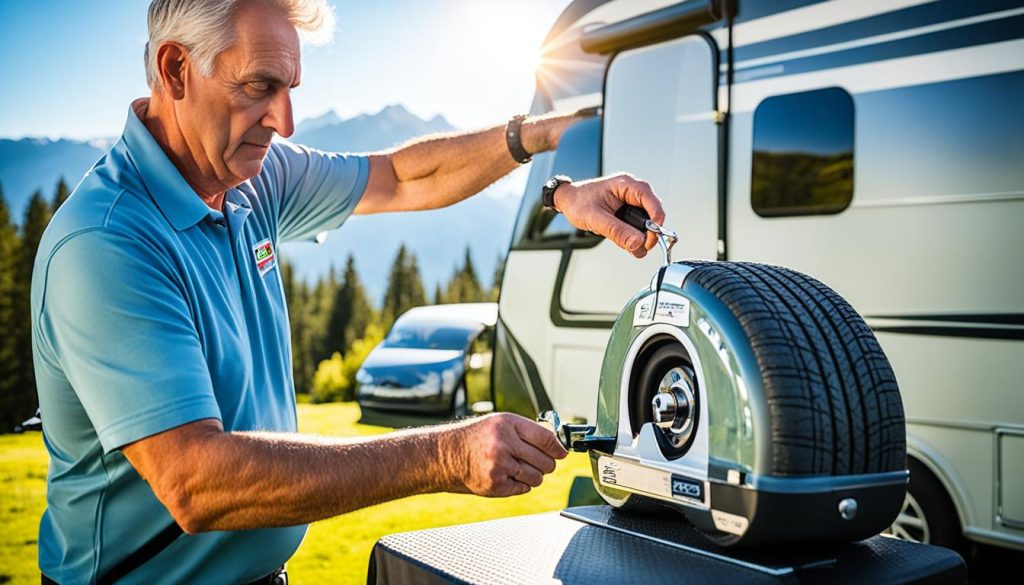
Towing Capacity and Weight Distribution: The Towing Triangle
When it comes to setting out for an adventure with a caravan in tow, mastering the balance between towing capacity, caravan weight distribution, and weight ratios forms the pinnacle of vehicle performance and safety—a concept often referred to as the ‘Towing Triangle’. This multifaceted approach ensures that the full ensemble of vehicle, tow ball, and caravan moves in harmony. In this segment, we dive into the pivotal relationship between your vehicle’s towing prowess and the maximum permissible laden mass (MTPLM) of your caravan.
Understanding Your Vehicle’s Towing Capacity
Knowing the towing capacity of your vehicle is the first critical step in safe caravan towing. It refers to the maximum weight your vehicle can pull while maintaining optimum performance and adherence to legal safety standards. Each vehicle comes with specified towing limits that should never be exceeded to ensure the integrity of your towing setup. Towing a caravan that is heavier than your vehicle’s specified capacity can lead to braking difficulties, reduced maneuverability, and potential legal issues.
Improving Tow Dynamics with Even Weight Distribution
Equally as important as knowing your vehicle’s towing capacity is ensuring the caravan’s weight is evenly distributed. This guards against the swaying motion that can occur when weight is biased towards the rear of the caravan. Strategic allocation of the caravan load influences the noseweight, enhancing stability and ensuring the overall towing system functions within safe parameters.
| Towing Capacity Considerations | Caravan Weight Allocation |
|---|---|
| Vehicle-specific towing limits | Noseweight compliance |
| Combined weight of towing vehicle and caravan (GTW) | Load distribution around the axle |
| Understanding kerbweight and its impact on towing dynamics | Securing items and avoiding load shift during transit |
| MTPLM adherence to avoid overloading | Weight ratios that favor front to middle placement |
This integrative approach ensures that you hit the road not only compliant with regulations but also with the confidence that your towing setup is primed for any challenges you may encounter along the way. When towing capacity aligns perfectly with considered weight distribution, your caravan becomes a true extension of your vehicle, leading to safer and more enjoyable road-going experiences.
Common Mistakes to Avoid in Caravan Noseweight Management
When it comes to maintaining caravan stability, properly managing noseweight is essential. Unfortunately, many caravan owners fall prey to common errors which can lead to towing hazards. Avoiding noseweight mistakes is not only a matter of safety but also of enjoying your journey without unexpected issues.
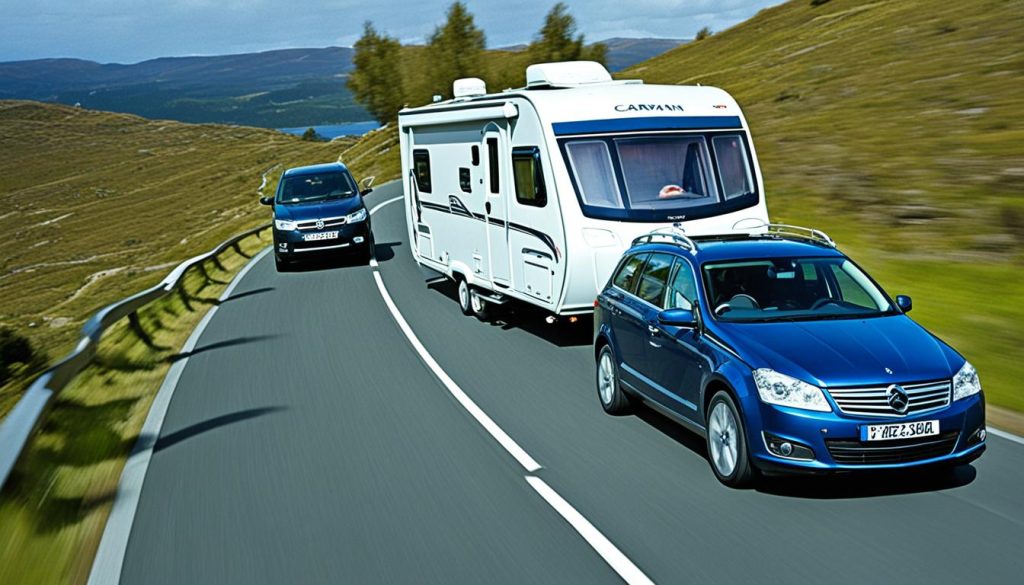
One significant error is not adhering to the recommended towing capacities. This has a direct impact on handling and braking, and can drastically increase the potential for accidents. Furthermore, improper loading that leads to an imbalanced weight distribution is a frequent oversight that can be avoided with careful planning and packing.
- Exceeding towing capacity or vehicle’s tow ball limit.
- Failing to distribute weight evenly across the caravan.
- Neglecting to perform regular noseweight checks.
- Forgetting to adjust the noseweight according to changes in load.
- Overlooking manufacturer’s guidelines for specific noseweight limits.
Many of these mistakes are the result of a lack of awareness or disregard for the importance of noseweight. These errors are easily preventable with diligent practices that prioritize caravan stability and safety.
| Common Mistake | Consequences | Preventative Action |
|---|---|---|
| Exceeding Towing Capacity | Ineffective braking, increased accident risk | Verify capacity and adhere to vehicle’s limits |
| Imbalanced Loading | Poor handling, caravan sway | Distribute load evenly, secure items properly |
| Neglecting Noseweight Checks | Unforeseen stability issues, legal implications | Consistent checks, especially before travel |
As a caravan enthusiast, integrating a checklist that includes verifying the noseweight and ensuring compliance with the towing vehicle’s specifications can make all the difference. Be vocal about these practices in your community to promote safety and enhance the overall towing experience.
In summary, understanding the importance of managing noseweight and the potential hazards associated with neglecting it is key. Effective caravan handling, road safety, and maintaining the integrity of your vehicle relies on avoiding these common weight management errors. Always stay informed and practice rigorous checking to guard against the risks associated with towing hazards.
Legal and Insurance Implications of Incorrect Noseweight
Ignoring the specified noseweight regulations can have significant legal repercussions for caravan owners and operators. These regulations are in place not just as guidelines but as enforceable standards that, when violated, might lead to actions from traffic authorities.
The Potential Consequences of Overlooking Noseweight Regulations
Failure to comply with noseweight regulations can result in more than just a slap on the wrist. Authorities may impose fines or issue penalty points on a driver’s license, which can accumulate and lead to a driving ban. These legal penalties reflect the serious safety risks posed by improperly loaded caravans.
How Caravan Insurance May Be Affected by Noseweight Oversights
When it comes to caravan insurance, non-compliance with noseweight guidelines can be costly. Insurers may deny claims for damages resulting from an accident linked to incorrect noseweight. This form of negligence might void coverages, leaving caravan owners vulnerable to significant expenses in the event of damage or third-party liability claims.
| Insurance Coverage Aspect | Impact of Noseweight Compliance | Impact of Noseweight Non-Compliance |
|---|---|---|
| Claims Approval | Potential approval when compliant | Possible denial of claims |
| Policy Premiums | No change or potential discount | Potential rate increase due to violations |
| Legal Liability Protection | Protection within policy limits | Limited or voided coverage |
In essence, maintaining the recommended noseweight not only ensures a safer towing experience but also safeguards the owner’s legal standing and financial interests via their caravan insurance. Owners should therefore regard the practice of checking and adjusting their caravan’s noseweight as an integral aspect of their pre-departure routine.
Advice from Experts: Tips for Maintaining the Right Noseweight
Securing caravan safety relies heavily on managing the correct noseweight, a task that can seem daunting to both newcomers and experienced caravan owners alike. However, by adhering to expert noseweight tips and following established best practices, anyone can maintain caravan stability and avoid towing hazards. Industry professionals emphasize the significance of regular checks, strategic item placement, and awareness of vehicle-specific requirements to ensure a secure and enjoyable towing experience.
Caravan Enthusiasts Share Their Noseweight Best Practices
Veteran caravan enthusiasts often suggest regular use of a noseweight gauge, which provides accurate readings to help maintain the recommended weight distribution. This simple practice is integral to avoiding imbalances that could lead to compromised handling and stability. Additionally, they advise keeping heavier items centralized and low within the caravan’s interior, which aids in lowering the center of gravity and reduces the risk of swaying during travel.
Professional Insights on Avoiding Towing Hazards
Professionals within the towing industry offer insights that go beyond the basics, such as investing in portable weighing machines for frequent travelers. Understanding the exact weight definitions for your particular tow vehicle and caravan model is also key. These professional insights ensure that individuals adhere to legal weight limits and maintain the optimal balance between tow vehicle and caravan, ultimately promoting safer journeys on the road.


